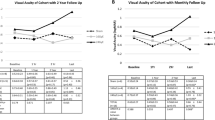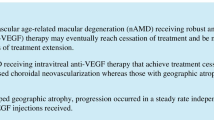Summary
Purpose: Several pilot studies have indicated that low-dose radiation therapy might have a beneficial effect on the course of choroidal neovascularization (CNV) in age-related macular degeneration (AMD). This study aimed to ascertain whether such treatment might halt the progression of neovascular AMD and whether a low or a high radiation dose should be applied.
Patients: The patients comprised some randomized to 0 vs 10 vs 36 Gy of radiation and (after a change of the study protocol became necessary) others who participated in a prospective, controlled non-randomized pilot study. Enclosed were eyes with visual acuity of ≥ 0.1 and ≤ 0.6 revealing a juxta-subfoveal CNV either of the occult type (type 1) or the classic type (isolated or as part of a predominantly occult lesion).
Results: Eyes treated with 10 Gy for occult CNV (n = 12) were subject to severe visual loss in 41.6 % of the cases compared to 38.5 % in the control group (n = 13) at 12 months of follow-up. For eyes treated with 10 Gy because of classic CNV, the corresponding figures were 33 % (n = 18) and 57 % (n = 14) respectively. At 18 months of follow-up, the percentages were 63 % and 75 % respectively. Fluorescein angiographic growth of classic and occult CNV could not be halted by 10 Gy, while a temporary growth retardation was observed in cases irradiated with 36 Gy.
Conclusion: In the study presented, the natural course of occult CNV could not be improved by irradiation with 10 or 36 Gy. In cases of classic CNV, low-dose irradiation with 10 Gy postponed severe visual loss by a maximum of 18 months. A positive treatment effect was also observed in cases irradiated with 36 Gy; however, a 25 % incidence of radiation retinopathy seems unacceptable.
Zusammenfassung
Hintergrund: Mehrere Pilotstudien haben positive Resultate für die Behandlung choroidaler Neovaskularisationen (CNV) auf Grund altersabhängiger Makuladegeneration mit niedrig dosierter Strahlentherapie gezeigt. Ziel dieser Studie war es aufzuzeigen, ob diese Behandlungsmethode die Progression bei AMD effektiv verhindern kann und ob eine hochdosierte Radiotherapie besser wirksam ist, als eine niedrigdosierte.
Patienten und Methode: Unsere Studie setzt sich einerseits aus einem randomisierten Kollektiv mit einer Dosis von 0 versus 10 bzw. 36 Gy, andererseits aus einem prospektiv kontrollierten Kollektiv zusammen. Eingeschlossen wurden Augen mit einem Fernvisus von ≥ 0.1 und ≤ 0.6 mit entweder juxta/subfovealer rein okkulter CNV vom Typ 1 oder klassischer CNV mit/ohne zusätzlicher okkulter CNV.
Ergebnisse: Insgesamt zeigten die mit 10 Gy bestrahlten okkulten CNV (n = 12) nach 12 Monaten in 41,6 % einen schweren Visusverlust von ≥ 6 Zeilen verglichen mit 31,5 % (n = 19) in der Kontrollgruppe. Bei den mit 10 Gy bestrahlten klassischen CNV (n = 18) kam es nach 12 Monaten in 33,3 % zu einem schweren Visusverlust, bei der Kontrollgruppe (n = 14) in 57 %. Nach 18 Monaten betrug dieser Anteil 62,5 % versus 75 %. Das Membranwachstum blieb mit 10 Gy unbeinflußt. Für 36 Gy zeigte sich zwar ein passagerer positiver Einfluss auf das Membranwachstum, die Visusresultate waren jedoch ohne signifikante Unterschiede zu denjenigen mit 10 Gy.
Schlußfolgerung: In der vorliegenden Studie konnte der natürliche Verlauf okkulter CNV durch eine Strahlentherapie nicht beeinflußt werden. Bei klassischen CNV ließ sich bei unseren Patienten durch niedrig dosierte Radiotherapie, entgegen den Resultaten bisheriger Pilotstudien, der schwere Visusverlust um höchstens 18 Monate hinauszögern. Die Bestrahlung mit 36 Gy zeigt zwar einen positiven Therapieeffekt, sie ist allerdings wegen des Auftretens einer Strahlenretinopathie in 25 % nicht vertretbar.
Similar content being viewed by others
Author information
Authors and Affiliations
Rights and permissions
About this article
Cite this article
Thölen, A., Meister, A., Bernasconi, P. et al. Radiotherapy for choroidal neovascularization in age-related macular degeneration. A pilot study using low- versus high-dose photon beam radiation. Ophthalmologe 95, 691–698 (1998). https://doi.org/10.1007/s003470050337
Published:
Issue Date:
DOI: https://doi.org/10.1007/s003470050337




